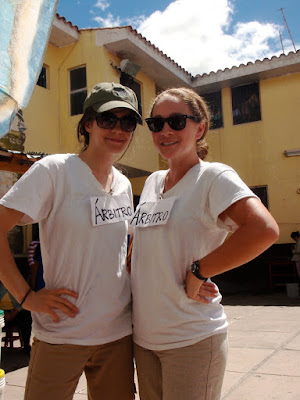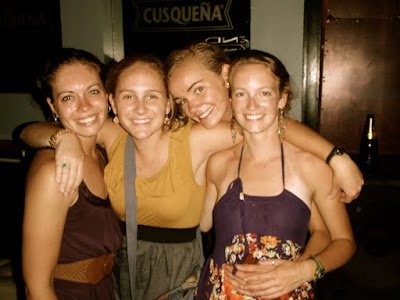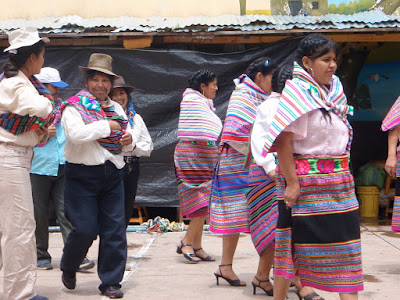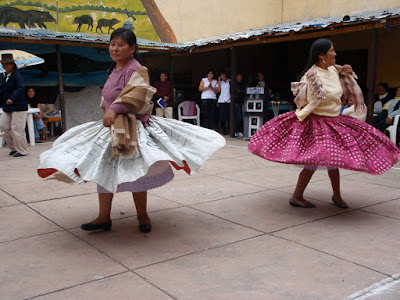WOW. What a week it’s been.
For the third installment of International Women’s Week on Thursday, we organized a soccer game for the women. I’m not sure how, but Kaitlan and I were roped into being the referees of the game; apparently necessary because none of the women within the prison were unbiased enough. We only ended up calling out-of-bounds and goals, but it was fun to be involved in the whole thing!
Las Árbitros, ie. Referees
Team picture!
On Friday, I joined Laura and Mike to Huanta, the “emerald of the Andes”. Apparently there was a waterfall and a lookout that we didn’t get to visit, but it was still cool to see another city in the area.
Beautiful view from the Pikimachay Cave, where they have found mammoth bones, as well as the first evidence of Maize in South America
And then the fun really began. Regardless of the fact that I somehow got sick with an impossibly sore throat over the course of Friday night, we got up at 6:30 am on Saturday and headed out on our “Llama Trek”. If there is one word to describe this experience it would be breathtaking, but if I could use a few more words they would be amazing, authentic, and eye-opening, to name a few. We began with a two-hour drive, but it hardly seemed long at all because of—here is the word—the BREATHTAKING view. It’s hard to liken it to any landscape I’ve seen before, and unfortunately the pictures don’t really do it justice, but suffice it to say that you’ve not experienced Peru until you’ve seen the Andean countryside.
The Andean countryside... So beautiful.
We weren't the only ones using the road.
Before the actual Llama Trek portion of the trip, we stopped at two pueblitos (little towns) to meet the locals; and my, how local they were. No more than six people came to greet us at the first pueblo, but their dress and demeanor were so traditional that it almost seemed staged. The women—regardless of age—were wearing the skirt, hat, and manta (shawl) so typical of the Andes, and the men had their traditional hats and manta’s as well. I ended up buying a hat from this town; handmade from Alpaca wool they spun themselves.
At the Santa Fe pueblo, where I got my hat
Couldn't resist posting this picture; Andean puppy in a sweater.
Does it get any cuter??
Between the first pueblo and the next we took a quick hike to a waterfall. Again—BREATHTAKING. At this point we were at about 15,000 feet, so our guide, Alejo, gave us all some Mate de Coca, (Coca Tea) which among many other properties happens to relieve altitude sickness. With Mate de Coca in hand, we headed to the waterfall.
My roommates and I drinking our Mate de Coca
"The hiiills are aliiiive with the sound of muuuusiiiicccc!!!"
Llamas!!
The second pueblo was warned of our arrival, and it seemed to me that the whole town showed up to meet us. In preparation the day before, we bought LOADS of bread, sweets, and a few school supplies to give to the villagers in exchange for the use of their Llamas and Alpacas during the trek. Handing out these gifts was totally hectic, as each Mamá has at least five children, but regardless, they were so excited it was hard to be anything but happy.
Niños at the second pueblo, who's Llamas we borrowed.
Due to the fact that my lungs were already weak because of my sickness, and that I would be spending the proceeding night in the Ayacucho hospital observing an OB/GYN (more on that in a second), I didn’t actually do the trekking part of our trip; I instead went with Alejo in the van to the top of the hill where we were going to meet the rest of the group. Not a bad deal, actually. On the way we stopped at a lone hut, where a middle-aged Peruvian woman sat spinning wool in her yard. Although from a distance her hut in seemed so “cute” and “quaint”, the reality of her living situation is anything but. She essentially lives alone, as her daughter (one of five; she would have had more children, she told us, if her husband hadn’t died) spends the daylight hours working with the Llamas and Alpacas. The hut itself was tiny, without electricity, water, mattresses, or heating of any kind (it gets quite cold at 15,000ft, even in Peru), and so isolated she probably never sees anyone but her daughter. We gave her some bread and sweets, and she said “thank you” about 20 times for visiting.

When we reached the top of the hill, I slept in the car for a while, knowing that any sleep was good sleep in light of my evening plans, and a while later I perched on a rock overlooking the valley and listened to some music. Not bad at all.
We were back at the CCS house around six, which gave me just enough time to eat, rest for a second, call Preston, and get ready for a long night before heading to the hospital. Basically, Marisol knows an OB/GYN who allows us to join him for his night shifts every once in a while. We were only observing, but what an observation experience it was! Natalie and I arrived at 8pm, and by 11pm we were in the operating room watching our first C-Section. Seeing as I had never before seen a (human) surgery, it was a bit dizzying at first, but I quickly got over it and watched the second C-Section of the night in it’s entirety. WOW. It was incredible to see the first few minutes of not one, but two baby’s lives in one night.
So although we haven’t been quite so lucky with the whole “healthcare volunteering thing” because of the strike, last night really did make up for it.


























































